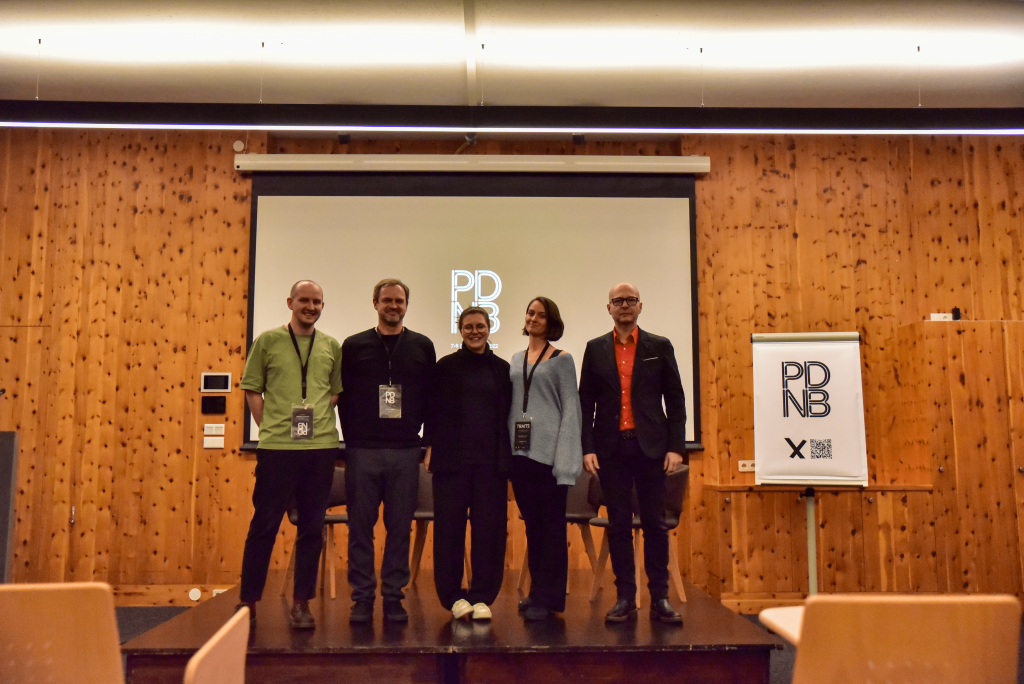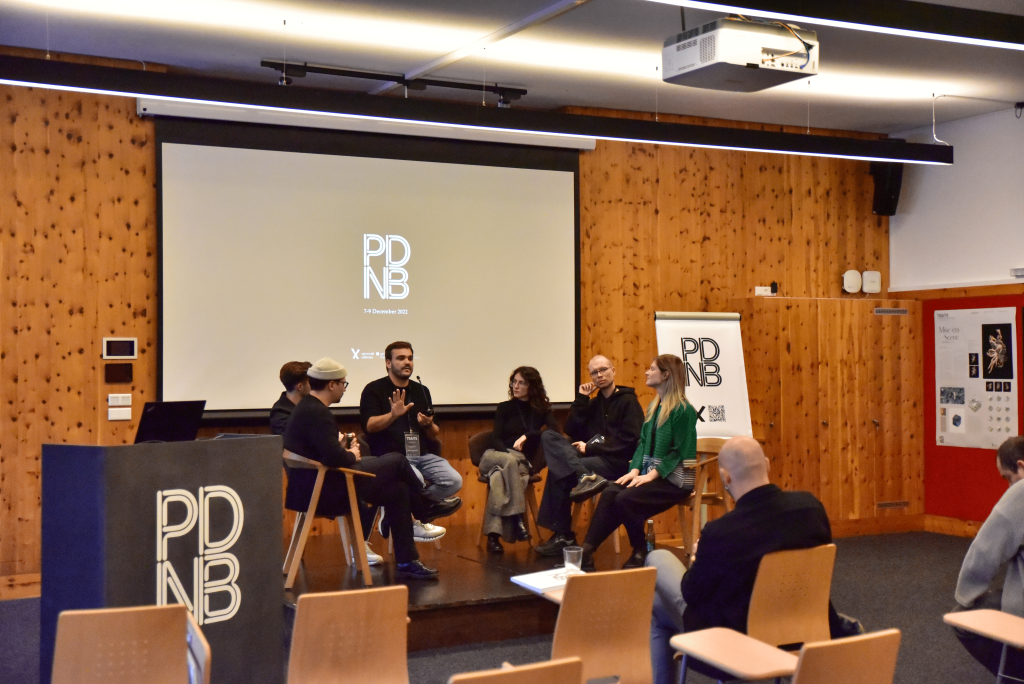Organised by the research group PDNB. Funded by the FWF-PEEK (Austrian Science Fund, Programme for Arts-based Research), led by Prof. Marjan Colletti at the Department for Experimental Architecture, Universität Innsbruck, Austria.









‘Face it – the Digital Revolution is over.‘
(Nicholas Negroponte, Beyond Digital, 1998)
In his 1992 book Neo-baroque: A Sign of the Times Italian semiologist Omar Calabrese suggested that the post-modern 1980s were infused with a pervasive neo-baroque spirit of ‘instability, polydimensionality, and change‘, which could be witnessed in the production and consumption of art and science, architecture and literature, entertainment and media. In the 2000 essay The Aesthetics of Failure: “Post-Digital” Tendencies in Contemporary Computer Music sonic artist Kim Cascone coined the term post-digital. Reflecting (in particular in electronic music) about the aesthetics of failure of the time beyond the digital revolution. Twenty/thirty years later, ‘some post-modern ideas of complexity and indeterminacy have been revived, and powerfully vindicated by today’s new science of computation’ (Mario Carpo, The Alternative Science of Computation, 2019) potentially bringing neobaroque and postdigital traits closer together. Both, the postdigital and the neobaroque are fertile fields of scholarly research and artistic production that have increasingly been adopted by multiple disciplines, whereby independently and never in combination with each other. Surprisingly so. Firstly, because design-research has become increasingly inter- and transdisciplinary. Secondly, because since the beginning, the notion of the ‘baroque’ has been a keyword in digital architectural theory and design. Therefore, two main questions arise: What are postdigital neobaroque traits? Further, what theoretical and aesthetical framework for architectural theory and design would the interlinking of neobaroque and postdigital suggest?
The TRAITS 2022 conference asked contributors to reflect upon the described interlinkage between the two terms and to find individual, open interpretations. Research has shown that there is no agreement on a common aesthetic canon given by the neobaroque and the postdigital paradigms: in architecture, for example, one post-digital trajectory aims at static, simple, 2D flat collages, whilst the other points to dynamic, complex, 4D animated computational systems. The conference addressed the latter and aimed to create a platform for like-minded theorists and artists to exchange ideas and visions and to discover each other’s work. The aim was to collect a broad spectrum of contributions to trigger a discourse on contemporary design and theory. Submissions by multidisciplinary teams and collaborations were strongly encouraged. All work dealt with explicit examples and included references to contemporary neobaroque postdigital aesthetics and ethics.
The conference engaged with the following questions that may but did not have to be answered:
o How do we break dichotomies in describing phenomena of a transition from digital to postdigital?
o How do we distinguish between the use of digital tools/methods and a digitalised society? Hence, is the use of digital tools conditional to the use of postdigital aesthetics?
o Is there a neobaroque and/or postdigital aesthetic/form that exists independently from historic references (the baroque, the digital)? Can we discuss a neobaroque aesthetic outside postmodern systems of referencing?
o Is the neobaroque similarly inherent to postdigital architectural theory and design of the 2010s and 2020s as the baroque was to digital architectural theory and design of the 1990s and 2000s?
Submission types:
Projects:
The call specifically asked for design work that extends the neobaroque concept of thought towards postdigital traits and vice versa, artistically illustrates theoretical ideas from this discourse and describes/operates on thresholds between the neobaroque and the postdigital. Project submissions were not limited to the presentation of design works per se, but could also include speculative experiments, theoretical arguments, mission statements, observations, multi-media (incl. AR/VR/MR) installations, or provocative artefacts. The projects were discussed and showcased in an onsite poster exhibition.
Theories:
Contributors were invited to use the stated questions as a starting point for their reflections. If particularly suitable examples were found, then the contribution was based on a comparative formal analysis of either built or designed architectural projects, art, literary works, performances, or video pieces — highlighting differences and/or similarities. This method is at the core of the theoretical side of the research project. Since the Swiss art historian Heinrich Wölfflin famously described, in Principles of Art History (1915), the formal differences between the Baroque and the Renaissance.
Discussions meet in the following conference spaces:
o The Grotto: materials, fabrication, interiorities.
o The Garden: nature, landscape, biodiversity, biotech.
o The Theatre: experience, media, entertainment, spectacle.
o The Palace: politics, economics, power.
o The Piazza: urbanity, public and civic spaces, exteriorities.
o The Boudoir: the body, gender studies, medicine, bionics.
Conference format:
The conference will be held in person, pending further sanitary measures. It is planned to visit the faculty of architecture and allow much time for discussions. More information concerning the venue can be found here:
https://www.uibk.ac.at/uz-obergurgl/
Keynotes:
Director, Centre for Transformative Media Technologies
Swinburne University of Technology
Melbourne, Australia
Reyner Banham Professor of Architectural History and Theory
The Bartlett School of Architecture
UCL London, UK
Invited Lecturer:
ao. Univ.-Prof. Dr. Markus Neuwirth
Institut für Kunstgeschichte
Universität Innsbruck, Austria
A.A. Dipl. Oliver Domeisen
The Bartlett School of Architecture
UCL London, UK
Scientific committee:
Univ.-Prof. Dipl.Ing. Marjan Colletti, Dott. MArch PhD (Bartlett School of Architecture, UCL, University of Innsbruck)
Dipl.-Ing. Dr. Peter Massin (University of Innsbruck)
Dipl.-Ing. Theresa Uitz BSc BA (University of Innsbruck)
Dipl.-Ing. Clara Jaschke BSc MRes (Bartlett School of Architecture, UCL, University of Innsbruck)
Andreas Körner BSc MArch (Bartlett School of Architecture, UCL, University of Innsbruck)
Reviewer committee:
Dipl.-Ing. Dr. Peter Massin (University of Innsbruck)
Dipl.-Ing. Theresa Uitz BSc BA (University of Innsbruck)
Dipl.-Ing. Clara Jaschke BSc MRes (Bartlett School of Architecture, UCL, University of Innsbruck)
Andreas Körner BSc MArch (Bartlett School of Architecture, UCL, University of Innsbruck)
Ass.-Prof. Dr. Roberto Bottazzi (University College London)
Univ. Ass. Uwe Brunner MArch (University of Innsbruck)
Pavlos Fereos MArch (University of Nicosia, University of Innsbruck)
Dipl.-Ing. Alexander Grasser BSc (Graz University of Technology)
Anirudhan Iyengar MArch (University of Innsbruck)
Maria Kuptsova MA (University of Innsbruck)
Ass.-Prof. Dr. Daniel Köhler (University of Texas at Austin)
Ass.-Prof. Dr. Guan Lee (Bartlett School of Architecture, UCL)
Mag.arc Galo Patricio Moncayo Asan MFA (University of Applied Arts Vienna)
Mag. Rasa Navasaityte (University of Texas at Austin)
Dipl.-Ing. David Stieler (ICD, University of Stuttgart)
Participants
Andrew Aziz, Patrick Danahy, Julian Edelmann, Eftychios-Nikolaos Efthymiou, Alberto Fernandez Gonzalez, Tzu-Jung Huang, Yu-Hsin Huang, Konstantin Jauck, Shambil Khan, Marine Lemarié, Giacomo Pala, Annarita Papeschi, Andrew Saunders, Johanns Schlusche, Vadim Smakhtin, Nicolas Stephan, Robert Stuart-Smith, Katerina Touska, Gonzalo Vaíllo, Emmanouil Vermisso, Prof. Angela Ndalianis
Conference proceedings:
All submissions will be part of the conference proceedings.
Important dates:
Abstract submission: 8th April 2022 (extended Deadline)
Notification of abstract acceptance: 1st May 2022
Full paper submission: 3rd July 2022
Final note of paper acceptance: 22nd August 2022
Registration deadline & Camera-Ready Paper Submission: 30th October 2022
Project Exhibition: 6th-10th December 2022
Conference: 7th-9th December 2022
Contact:
traits2022-pdnb@uibk.ac.at
Institut für Experimentelle Architektur – Hochbau
Technikerstraße 21
6020 Innsbruck (Austria)



